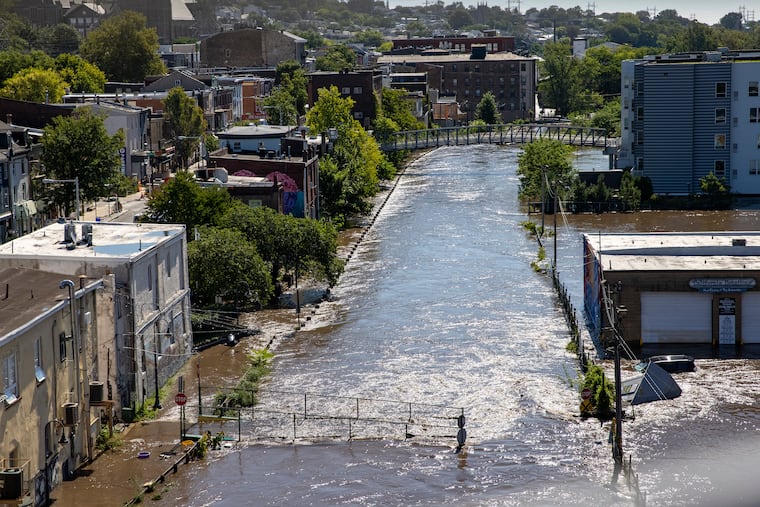Biden hints at aid for states but it’s unclear whether Pa. and N.J. will get federal disaster relief
Pennsylvania's waiting to see if it will receive federal disaster relief.

Pennsylvania residents and businesses are waiting to find out whether the commonwealth will receive federal relief for damage and a disaster declaration after the region was hit by the remnants of Hurricane Ida.
“It’s too early at this point to tell whether or not the damage we’ve seen from the remnants of Ida will meet criteria for a federal disaster declaration for either Individual Assistance or Public Assistance,” said Ruth Miller, director of communications for the Pennsylvania Emergency Management Agency, in response to an email.
Her agency’s assessing damage with county officials, but the job won’t be done for several days, she said.
FEMA’s Public Assistance program provides funding to state, county and local governments and eligible nonprofits to repair or replace damaged or destroyed infrastructure. To qualify, counties must each meet thresholds for storm-related costs and the state overall must have had damages of a least $19.6 million.
On Tuesday, Gov. Tom Wolf signed a proclamation of disaster emergency to enable state agencies to more quickly respond to request for assistance from counties. Ida was the fifth-most powerful storm to ever strike the U.S., likely causing tens of billions of dollars in flood, wind, and other damage. The storm’s remnants dropped devastating rainfall across Pennsylvania, New Jersey, and New York on Wednesday, killing at least 25 people and causing significant disruption to major population centers.
President Joe Biden on Thursday pledged help for New Jersey and Pennsylvania. Biden said he spoke with Gov. Phil Murphy and planned to talk to Wolf, as well.
But details are scant. “Will it be grants, loans? No one knows. What does it mean for Pennsylvania and how can we get businesses back on our feet?” said Gene Barr, president of the Pennsylvania Chamber of Business and Industry in Harrisburg.
“Our chamber is on alert and coordinating with the county and U.S. Chamber of Commerce,” said Guy Ciarrocchi, president of the Chester County Chamber of Business & Industry.
“Sadly, we may not know the full extent of the damage until Friday or Saturday, especially around the Coatesville, Downingtown and Phoenixville, as the waterways haven’t crested yet,” he said.
Pennsylvania municipalities are still assessing damage--information critical to meeting the criteria for what’s known as a “Major Presidential Disaster Declaration.” Businesses should contact the local municipal office and indicate storm damage they’d like to report to Emergency Management coordinators.
“As we collect all the damage reports from the municipalities, we’ll be compiling this information and sharing it with the Pennsylvania Emergency Management Agency (PEMA),” wrote Robert J. Kagel, County Administrator for Chester County Commissioners’ Office in an e-mail late Thursday night. “Once PEMA has collected sufficient documentation, the Governor will submit a request to the Federal Emergency Management Agency (FEMA) for a Major Presidential Disaster Declaration.”
The Major Presidential Disaster Declaration will make available low-interest loans from the Small Business Administration for businesses to make repairs and possibly cover operating losses due to the disaster. More information on the SBA program may be found here: https://www.sba.gov/funding-programs/disaster-assistance.
For additional resources on cleaning up after the flood, here is a link to Chester County’s Flood Recovery Guide. If any business employees need housing in Chester County, they can call 2-1-1 and indicate they need services, he added.
“These types of disasters and how they’re covered by insurers is a challenge,” said Sam Marshall, president of the Insurance Federation of Pennsylvania.
California received an emergency declaration this past week due to fires, which have burned from one side of the Sierra Nevada mountain range to the other.
Business interruption
Struggling to recover from the pandemic shutdown, many Pennsylvania businesses are now hurting from the aftermath of Ida’s flooding.
Hurricanes and other natural disasters wreak havoc long after the storm departs. And business owners must now investigate their insurance coverage and begin filing claims, said Marshall.
A property insurance policy covers the physical damage to a business. A business income insurance (BI) policy covers the loss of income that would have been earned, according to accounting and advisory firm EisnerAmper.
Wind damage from Ida will generally be covered by private insurers, the Consumer Federation of America said.
.
But insurers have been steadily increasing the deductibles for hurricane wind damage and imposing other, sometimes draconian, policy limitations, said J. Robert Hunter, CFA’s director of insurance. Coverage changes are often buried in renewal paperwork that consumers may not understand or even read.
“Most people who had flood damage from this storm will be covered by flood insurance,” Hunter added. “But if you don’t have flood insurance, you won’t be covered.”
Flood insurance is offered through the National Flood Insurance Program (NFIP), the program administered by FEMA and launched in 1968 after the Category 4 Hurricane Betsy destroyed sections of Florida and Louisiana. Many of those who suffered losses had no insurance because of its high cost.
To better reflect current flood risk, NFIP and the FEMA are updating technology and data to flood maps nationwide starting Oct. 1. “It’s the first time FEMA has updated their risk model since the 1970s,” said Michael Lopes of the nonprofit First Street Foundation, a research organization that looks at the impact of climate change.
Property owners in New Jersey and Delaware face some of the highest risks in the nation for flooding over the next few decades, according to First Street. The flood risk research firm says that’s because of rising temperatures in the atmosphere and oceans causing hurricanes to reach farther north.